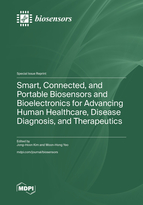Smart, Connected, and Portable Biosensors and Bioelectronics for Advancing Human Healthcare, Disease Diagnosis, and Therapeutics
A special issue of Biosensors (ISSN 2079-6374). This special issue belongs to the section "Biosensors and Healthcare".
Deadline for manuscript submissions: closed (20 September 2022) | Viewed by 35027
Special Issue Editors
Interests: biosensors; microfluidics
Interests: nanomanufacturing; biosensors; bioelectronics; soft robotics; human–machine interfaces
Special Issues, Collections and Topics in MDPI journals
Special Issue Information
Dear Colleagues,
Research and development related to Smart, Connected, and Portable Biosensors and Bioelectronics have been a game-changer in the fields of diagnostics and health management. Unlike conventional biosensors, these devices allow rapid, accurate, and on-site detection of biomarkers, which helps to prevent disease spread by the source control. This Biosensors Special Issue on “Smart, Connected, and Portable Biosensors and for Advancing Human Healthcare, Disease Diagnosis, and Therapeutics” is dedicated to reporting advances towards addressing current challenges and the future scope of the field of portable biosensors and bioelectronics. Topics include but are not restricted to:
• Applications of portable biosensors and handheld POC devices, ranging from the support of primary healthcare to food and environmental safety screening;
• Advances in the design and optimization of portable biosensor and bioelectronics systems;
• Various technologies for fabricating portable diagnostic devices and biosensors;
• Novel materials for bioelectronics and power sources;
• New biomarkers for portable biosensors and bioelectronics;
• Signal processing and wireless transmission schemes for smart biosensors and bioelectronics;
• New sample preparation methods for portable biosensors;
• Wearable systems for health monitoring and interventionl
• Systems engineering and integration for smart and portable sensors and bioelectronics.
Research papers, short communications, perspective article, and reviews are all welcome. Prior discussion with the Guest Editors would be helpful if the author(s) are interested in submitting a review/perspective article.
Dr. Jong-Hoon Kim
Prof. Dr. W. Hong Yeo
Guest Editors
Manuscript Submission Information
Manuscripts should be submitted online at www.mdpi.com by registering and logging in to this website. Once you are registered, click here to go to the submission form. Manuscripts can be submitted until the deadline. All submissions that pass pre-check are peer-reviewed. Accepted papers will be published continuously in the journal (as soon as accepted) and will be listed together on the special issue website. Research articles, review articles as well as short communications are invited. For planned papers, a title and short abstract (about 100 words) can be sent to the Editorial Office for announcement on this website.
Submitted manuscripts should not have been published previously, nor be under consideration for publication elsewhere (except conference proceedings papers). All manuscripts are thoroughly refereed through a single-blind peer-review process. A guide for authors and other relevant information for submission of manuscripts is available on the Instructions for Authors page. Biosensors is an international peer-reviewed open access monthly journal published by MDPI.
Please visit the Instructions for Authors page before submitting a manuscript. The Article Processing Charge (APC) for publication in this open access journal is 2700 CHF (Swiss Francs). Submitted papers should be well formatted and use good English. Authors may use MDPI's English editing service prior to publication or during author revisions.
Keywords
- Portable biosensors
- Wearable and implantable bioelectronics
- Wireless sensors and systems
- Smart biosensors and bioelectronics
- Machine learning-enabled healthcare
- Smart systems for advanced disease diagnosis
- Smart systems for advanced therapeutics








